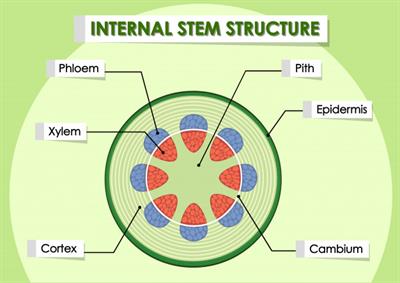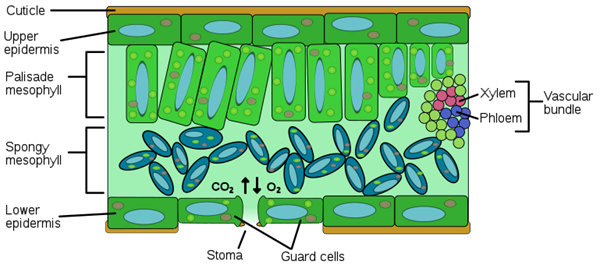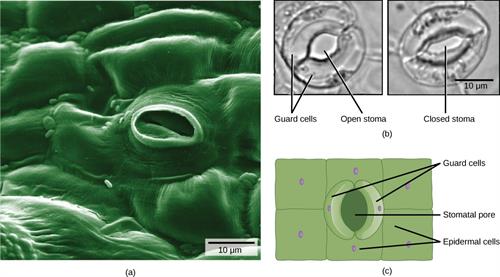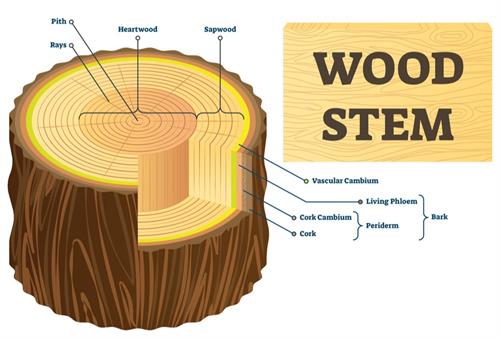
PUMPA - SMART LEARNING
எங்கள் ஆசிரியர்களுடன் 1-ஆன்-1 ஆலோசனை நேரத்தைப் பெறுங்கள். டாப்பர் ஆவதற்கு நாங்கள் பயிற்சி அளிப்போம்
Book Free DemoPlants require protection from external environment for their survival. Their internal structure and tissues are protected from the external environment by means of specific tissues called as protective tissues. These tissues present in plant's stem, roots, leaves, etc, also helps plants by preventing the loss of water.
These tissues protects the plants and also prevent the plants from loosing water. There are two types of protective tissue viz.,
- Epidermis
- Cork (or) Phellum

Internal structure of a stem
Epidermis:

Anatomy of leaf
Properties and functions of epidermis:
- Epidermis cells are mostly flat cells.
- In epidermis tissue, outer and sidewalls of the epidermis, cell is thicker than the inner wall.
- For some plants living in dry habitats, storage of water is significant and critical. So epidermis layer is thick in those plants to avoid the loss of water.
- It protects the entire surfaceof the plant.
- In aerial parts of the plant, epidermal cells in its outer surface secrete a waxy water-resistant layer. The epidermis of the desert plant has a thick layer of cutin that is called cuticle. In turn, this layer protects the surface of the plant against water loss, mechanical injury, and the parasitic fungi invasion.
- Epidermal cells is a continuous layer without any intercellular spaces to give protection to the plant.
Epidermis of leaf:
- Outermost layer of the leaf.
- It consists of small pores called Stomata.
Functions of stomata:
- Stomata is enclosed by two kidney-shaped guarding cells that are necessary for gaseous exchange in the leaf.
- Stomata also facilitates transpiration, a process by which loss of excess water in the form of water vapour through leaves' surface.

Openings called stomata (singular: stoma) allow a plant to take up carbon dioxide and release oxygen and water vapor. The (a) colorized scanning-electron micrograph shows a closed stoma of a dicot. Each stoma is flanked by two guard cells that regulate its (b) opening and closing. The (c) guard cells sit within the layer of epidermal cells (credit a: modification of work by Louisa Howard, Rippel Electron Microscope Facility, Dartmouth College; credit b: modification of work by June Kwak, University of Maryland; scale-bar data from Matt Russell)
Epidermis of roots:
- Epidermal cells of roots forms the outermost layer of long hair-like structures which creates larger absorptive surface area.
- Epidermal cells helps in the absorption of water in roots.
Cork:
- Cork is constituted by a layer of cells formed by cortex, located in a strip of secondary meristem.
- Cork cells are dead and compactly arranged without intercellular spaces. Cork have a substance called suberin in their walls that makes them impervious to gases and water.

Wood stem vector illustration
- It is formed by secondary lateral meristem called cambium.
- It replaces the epidermis of older roots and stems.
- It is also known as phellum.
- Cells of cork are dead, compactly arranged and have no intercellular spaces. It forms bark of the tree (several layers thick).
- It prevents water loss from evaporation.
- It protects plants from the parasites and other harmful microorganisms.
Reference:
https://www.freepik.com/free-vector/diagram-showing-internal-stem-structure_5840638.htm
https://openstax.org/books/biology/pages/30-2-stems
https://openstax.org/books/biology/pages/30-2-stems
https://commons.wikimedia.org/wiki/File:Leaf_anatomy.svg